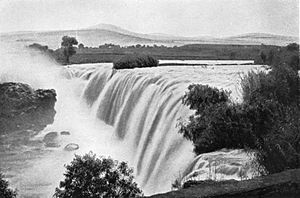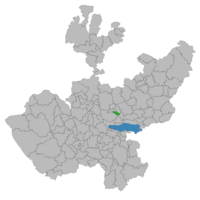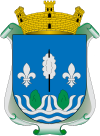El Salto, Jalisco facts for kids
Quick facts for kids
El Salto
|
||
|---|---|---|
|
Municipality and city
|
||

El Salto de Juanacatlán, circa 1909
|
||
|
||

Location of the municipality in Jalisco
|
||
| Country | ||
| State | Jalisco | |
| Area | ||
| • Total | 92.75 km2 (35.81 sq mi) | |
| • City | 6.28 km2 (2.42 sq mi) | |
| Population
(2020 census)
|
||
| • Total | 232,852 | |
| • Density | 2,510.53/km2 (6,502.3/sq mi) | |
| • City | 27,876 | |
| • City density | 4,439/km2 (11,497/sq mi) | |
El Salto is a city and a municipality (like a county) in the central part of the Mexican state of Jalisco.
The municipality covers about 92.75 square kilometers (about 35.8 square miles). In 2020, it had a population of 232,852 people. It is surrounded by other municipalities like Tlaquepaque, Tonalá, Juanacatlán, and Tlajomulco de Zúñiga. El Salto became its own municipality on December 22, 1943, separating from Juanacatlán.
Contents
Communities in El Salto
El Salto is made up of several important communities, each with its own population and area. Here are some of the largest ones:
| Name | Population (2020) | Area |
|---|---|---|
| Las Pintas | 42,576 | 6.81 km2 |
| San José del Castillo | 39,246 | 5.08 km2 |
| Las Pintitas | 29,445 | 8.9 km2 |
| El Salto | 27,876 | 6.28 km2 |
| San José el Verde (El Verde) | 21,834 | 5.89 km2 |
| El Quince (San José el Quince) | 21,215 | 4.57 km2 |
| Galaxia Bonito Jalisco | 20,381 | 1.26 km2 |
| Agua Blanca | 11,505 | 0.13 km2 |
A Look Back: History of El Salto
The area of El Salto has a long and interesting history, dating back to the time of the Spanish conquest.
Early Spanish Influence
In 1530, a Spanish explorer named Nuño de Guzmán was sent by Hernán Cortés to explore and conquer new lands. On January 20, 1530, his group crossed the Lerma river. They arrived in Tonalá on March 24, taking control of the village and the surrounding region for Spain. The next day, Nuño de Guzmán claimed the lands south of the Santiago River and around Lake Chapala for the King of Spain.
Later, in 1606, a wealthy man named Diego de Porres Baranda received a large piece of land. This land was located between the town of Santa Fe Valley and Juanacatlán.
The Jesuit Era and Big Estates
During the 1600s, a large estate called Toluquilla hacienda stretched from Analco to the famous waterfall of El Salto de Juanacatlán. This huge estate belonged to the Company of Jesus, also known as the Jesuits, who were a group of religious clergy.
However, in June 1767, King Carlos III ordered all Jesuits to leave Spanish territories. Because of this, the Toluquilla estate was given to Mr. Francisco Javier de Vizcarra.
The Famous Waterfall and Local Growth
By 1818, another important estate called "Jesús María" existed. This estate was special because it was home to the amazing Juanacatlán Falls. This waterfall was nearly twenty meters (about 65 feet) high and over 130 meters (about 426 feet) wide!
In 1836, a Spanish merchant named Don Francisco Martínez Negrete Ortiz de Rozas bought the "El Castillo" estate. He used the water from the Rio Grande Santiago to grow crops like sugarcane and chickpeas. He also built a mill, which was called "El Molino." The areas of "El Castillo," "Jesús María," "La Azucena," and "El Molino" eventually grew together to form what we now know as El Salto.
When Francisco Martínez Negrete Ortiz de Rozas passed away, his daughter, María Dolores Martínez Negrete y Alba, inherited these large estates.
Environmental Challenges
El Salto is located along the Rio Grande de Santiago, which is one of Mexico's largest rivers. Sadly, it is also one of the most polluted.
River Pollution and Its Effects
The Santiago River receives waste from many factories and homes in the area, including the Guadalajara Metropolitan Area. A wall built at the top of the waterfall to help a hydroelectric plant has caused polluted water to get stuck. This creates a place where toxic mud collects, leading to bad smells and many mosquitoes.
The pollution in the water and air can affect the health of people living in El Salto. It can also harm the plants and animals in the area. Local groups are working to raise awareness and find solutions to these environmental problems.
Music and Celebrations
El Salto is known for its lively music scene and many traditional celebrations.
Local Music Groups
Many popular musical groups have come from El Salto, playing different styles of music.
Bands
- The Dominant Band El Cerrito
- Youth Star Band
- Banda Los Chicos Tambora
- Los Rosalitos Band
Groups
- Latin Renewal Group
- Tropical Latino Group
- Latin Rhythm Group
- Latin Monkeys
- Argos
- Sonora Tattoo (from Juanacatlan, a nearby municipality)
Festivals and Holidays
El Salto celebrates both national and religious holidays throughout the year.
National Holidays
- Anniversary of the Independence of Mexico: Celebrated on September 16th.
- Anniversary of the Mexican Revolution: Celebrated on November 20th.
Religious Festivals
- Holy Week: Observed on Thursday and Good Friday.
- Feast in honor of the Admirable Virgin Mother: Celebrated from October 12th to 20th.
- Festivities in honor of the Holy Cross of La Parroquia La Santa Cruz: Held from April 25th to May 3rd.
- Festivities in honor of San Isidro Labrador, in Las Pintas: Celebrated from May 7th to 15th.
- Festivities in honor of San Jose, in San José del Castillo: Celebrated from March 11th to 19th.
Important People from El Salto
El Salto has been home to several notable individuals who have made important contributions.
- José de Jesús Muñoz Limón: A lawyer who also served as the governor of Jalisco.
- Mike Laure: A famous singer, songwriter, and actor.
- Concepción Becerra de Celis: A respected teacher and principal of the Jalisco Normal School.
- Pedro Valadez "Peyul": An activist who works to promote fairness and equality for everyone.
Community Action Groups
Citizens in El Salto are actively working to improve their community.
Caution Collective
The Caution Collective is a group of citizens who want to make a positive change. Started in January 2011, their goal is to improve the quality of life for people in El Salto. They do this by promoting culture and arts, and by encouraging citizens to use their skills to solve social problems and build a stronger community identity.
Waterways of El Salto
The municipality's water resources are part of the Lerma-Santiago river system.
Santiago River and Juanacatlán Falls
The main river is the Santiago River, where the beautiful waterfall of El Salto de Juanacatlán is located. There are also smaller streams like the Ahogado stream and natural springs.
The Santiago River is one of the most important rivers in the region.
See also
 In Spanish: El Salto (Jalisco) para niños
In Spanish: El Salto (Jalisco) para niños




